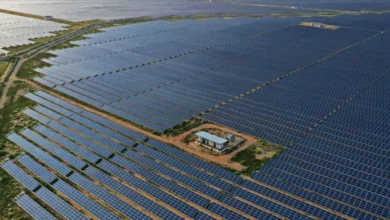Banks in Kuwait embrace Gulf expansion amid local project slowdown
The officials from the Central Bank of Kuwait requested the cross-border credit policies of each local bank, with a particular focus on those in the Gulf region. The request was made in light of supporting a financial expansion strategy in foreign markets, including neighboring ones.

-
Digitally, the first quarter of 2024 ended with relatively weak performance. Historical trends indicate that local credit growth remained low, real estate activity was weak, and project activity declined significantly during this period.
-
Local banks’ rising foreign syndicated loans signal increased credit leverage, utilizing liquidity surpluses for client financing abroad.”
-
Local banks expanded into foreign markets with strategic financing, leveraging loans in the Gulf through syndicated loans, bonds, and direct contributions.
-
According to data from the Central Bank of Kuwait, the balance of total credit facilities increased in March on a monthly basis by 0.96 percent and amounted to 519.9 million, after being 53.851 billion at the end of last January.
According to sources familiar with the matter, Al Rai newspaper learned that officials from the Central Bank of Kuwait recently met with treasury managers from local banks.
During this meeting, the Central Bank officials requested the cross-border credit policies of each local bank, with a particular focus on those in the Gulf region. The request was made in light of supporting a financial expansion strategy in foreign markets, including neighboring ones.
The sources said that the Central Bank’s position in this regard comes as part of a supervisory effort to ensure the soundness of these policies. They aim to prevent local banks from being exposed to external risks resulting from credit policy makers increasingly turning to financing in certain aggregated and direct foreign markets after local lending has increased. This shift is due to the slow pace of offering development projects, which conflicts with the banks’ plans to achieve sustainable growth.
Sources stated that the supervisory questions that a banker must answer are not limited to determining the banks’ policies for external financing. They also include providing information about the sources of banks’ financing for their current and future external loans, what actions they would take if their liquidity levels were affected for any reason, and the risks they face to regulatory ratios if any of them falter.
Digitally, the first quarter of 2024 ended with relatively weak performance. Historical trends indicate that local credit growth remained low, real estate activity was weak, and project activity declined significantly during this period compared to the improvement seen in 2023.
Supervisory instructions
The sources stated that the open banking supervisory discussion in this regard does not reflect interference by the Central Bank in demarcating the banks’ credit policies. Rather, it is simply a supervisory follow-up to ensure the soundness of these policies and their compliance with supervisory instructions, including risk distribution, financing weights, and their impact on liquidity ratios for local lending.
This is especially pertinent given the expected improvement in project awards for the remainder of 2024, with projects worth 6.3 billion dinars expected to be awarded.
The sources also pointed out that local banks entering into external syndicated loans is not new. However, what has changed is the recent increase in the level of financing granted by local banks to clients abroad. This increase is part of an effort to enhance their credit leverage within the limits that allow them to utilize their accumulated liquidity surpluses.
Double attendance
The sources stated that each bank will provide the Central Bank with its foreign credit policy, explaining its concentration in each market and the reasons for that concentration.
They will also outline their future plans in this direction, particularly banks that intend to increase their financing presence abroad in response to growing demand in neighboring markets for borrowing to finance development projects.
They pointed out that local banks currently enjoy comfortable levels of liquidity and a solid capital base. Additionally, they are taking into account the rise in interest rates, which makes them well-prepared to benefit from any recovery seen in spending on development projects, both externally and locally. This is supported by selective conservative policies aimed at reducing the risk of unexpected defaults.
The sources revealed that credit policy makers have been attentive since the beginning of the transformation of the Gulf region, noting the substantial increase in the financing pool required in its markets.
This increase is due to the boom in offering massive projects across all sectors, attracting billions in investments. Consequently, there’s an additional need in these markets to attract financing from outside their regions, resulting in an increase in local bank liquidity that needs to be drained.
Increase leverage
The sources pointed out that the recent expansion of local banks into foreign markets was accompanied by well-studied financing scenarios. They succeeded in increasing the leverage of their loans in the Gulf through various means, such as participating in syndicated loans ‘bonds and instruments’ or directly contributing to financing government loans or private sector companies.
They added that the contributions of local banks to external financing varied, with the size of the possible credit space for each bank being determined by its capital strength. Additionally, the extent of its ability to exploit surplus liquidity space is crucial, provided that a portion of it is directed towards financing abroad without affecting the regulatory ratios established for the ladder arrangement entitlements.
Bank officials believe that their increased lending abroad in the recent period was aimed at compensating for the slowdown in local financing growth, especially since these financings are tied to large-scale development plans in the Gulf. They are taking into account the risks associated with the continued slowdown in the country’s development process, which has resulted in low implementation rates.
Healthy behavior
The sources explained that the banks’ expansionary move towards foreign markets and meeting the growing financing needs in the Gulf is considered healthy banking behavior. This indicates that the greater the percentage of the local bank’s contribution to foreign loans, the more capable it is of achieving dual benefits. These benefits include reducing its stock of excess liquidity available for lending in guaranteed financing and then reducing its cost of funds with a suitable interest margin.
As an expected result, local banks will achieve additional operational benefits and enhanced accounting by reaping margins from the rise in interest rates recorded so far, especially with the US Federal Reserve fixing interest rates at its meeting last Wednesday.
Consequently, avoiding losses in unrealized business revenues from the accumulation of levels of liquidity available for lending, and reducing the cost of non-working deposit funds, or more precisely, those that are parked in an emergency despite being available for lending.
Growth rates and indicators
According to data from the Central Bank of Kuwait, the balance of total credit facilities increased in March on a monthly basis by 0.96 percent and amounted to 519.9 million, after being 53.851 billion at the end of last January.
Consumer loans declined during March by 3.1 percent, by about 6.1 million to 185.5 million, while housing facilities increased by 2.4 percent, by about 1.8 million to 75.6 million, and other loans decreased by 2 percent, by about 4.2 million, to 201.2 million.
Trade sector financing witnessed a jump of 53.3 percent, amounting to about 76.9 million, from 144.1 million in February to 221 million.













